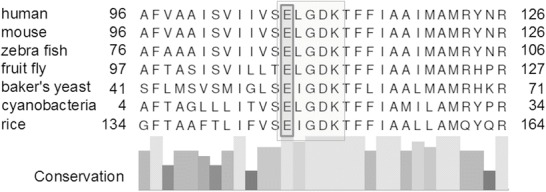Fig. 5.

Cross-species alignment of TMEM165 and other members of the UPF0016 family. Alignment was prepared using the alignment tool from UniProt homepage (The UniProt Consortium 2014). Reference sequences for human (NP_060945.2), mouse (NP_035756.2), zebra fish (NP_997848.1), fruit fly (NP_650426.1), baker’s yeast (Saccharomyces cerevisiae, NP_009746.1), cyanobacteria (Synechocystis sp., NP_442278.1), and rice (NP_001068053.1). Columns below indicate the degree of conversation. The motif ELGDK (light gray box) is highly conserved and characteristic for proteins of the cation transporter UPF0016 family, indicating its functional importance. Most proteins of this family have two regions containing this motif, each with three predicted transmembrane regions and a central hydrophilic loop (Demaegd et al. 2013). Rosnoblet et al. (2013) suggested that the E108LGDK motif might be crucial for putative cation recognition signals. Since the patient’s mutation affects the glutamic acid on position 108 (“E”, dark gray box) in human TMEM165, one of the two negatively charged amino acids in this motif, this mutation might critically interact with the normal protein function as a calcium transporter. This could explain the severe phenotype in the patient
